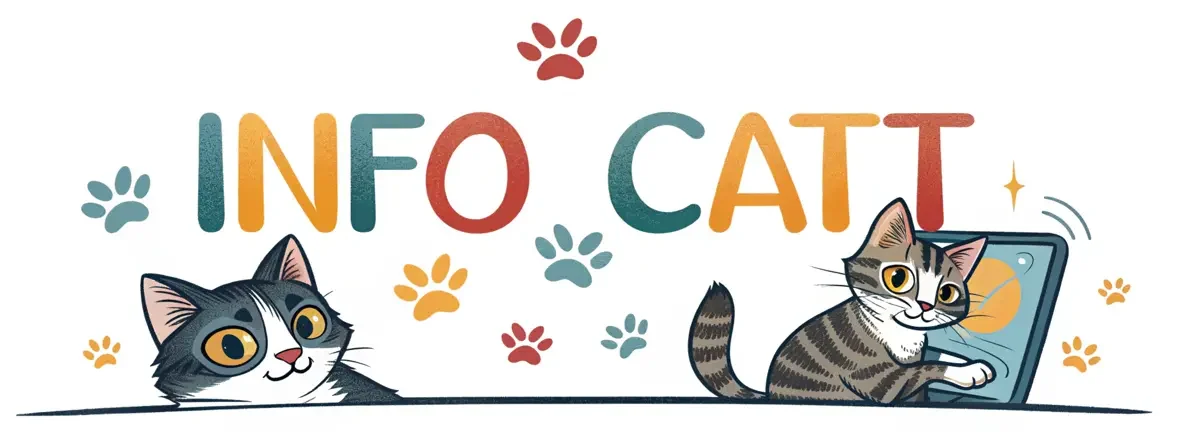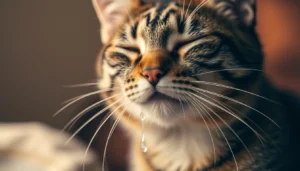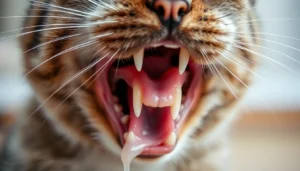I never expected my quiet tabby to become a drool machine overnight. One morning, I noticed wet spots on her favorite blanket. I started wondering about the mysterious world of cat drooling. If you’re asking yourself “why is my cat drooling,” you’re not alone in this puzzling feline mystery.
Cat drooling can mean many things – from completely normal behavior to potential health concerns. Your furry friend might be experiencing something simple like contentment. Or, they might be facing a more complex medical issue that requires attention. Understanding cat drooling causes is crucial for every responsible pet owner.
This guide will help you decode the secrets behind your cat’s unexpected wetness. We’ll explore everything from typical saliva situations to warning signs that might need veterinary intervention. Get ready to become an expert in feline mouth moisture!
Understanding Normal vs. Excessive Cat Drooling
Cat salivating can be normal or a sign of health issues. Not all drooling is a problem, but knowing the difference is key for your cat’s health.
Cats drool for many reasons, and some drooling is natural. Knowing when drooling is too much can help keep your pet healthy.
When Is Drooling Considered Normal?
Normal cat drooling happens in certain situations:
- During moments of extreme relaxation or contentment
- When anticipating a favorite meal
- While receiving gentle petting or experiencing positive stimulation
- As a response to pleasant smells or tastes
Signs of Problematic Drooling
Excessive drooling in cats can mean health issues. Look out for these signs:
- Continuous, uncontrolled saliva production
- Drooling accompanied by bad breath
- Changes in eating or drinking habits
- Visible discomfort while salivating
Common Drooling Patterns in Cats
Different cats drool in their own ways. Some breeds drool more than others. Stress, dental issues, or underlying medical conditions can affect these patterns.
If your cat’s drooling changes suddenly, watch closely. If concerns last, talk to your vet.
Why Is My Cat Drooling: Common Medical Causes
Understanding why your cat drools can help spot health issues early. Cats usually don’t drool unless there’s a reason. It’s important to know the signs of illness in cats to keep them healthy.
Many medical conditions can make your cat drool more than usual. This can also affect their appetite. Some main concerns include:
- Oral infections that cause pain and discomfort
- Inflammatory diseases affecting the mouth
- Viral or bacterial infections
- Digestive system complications
If your cat is drooling and not eating, it might be a sign of a serious problem. These issues can range from simple irritations to serious conditions that need a vet’s help.
“Persistent drooling accompanied by appetite loss should never be ignored,” veterinary experts warn.
Some medical issues that might cause drooling include:
- Salivary gland disorders
- Nerve damage
- Traumatic mouth injuries
- Toxic substance exposure
Watching your cat’s behavior and physical signs can help you know when to see a vet.
Dental Problems and Oral Health Issues That Cause Drooling
Dental health is key to your cat’s happiness. Drooling in older cats can mean they have dental issues. Knowing these problems can help you see if your cat is in pain.
Cats are good at hiding pain, making dental problems hard to spot. Is cat drooling a sign of pain? Often, yes. Drooling can be your cat’s way of saying something’s wrong in their mouth.
Gingivitis and Periodontal Disease
Gingivitis is gum inflammation that hurts your cat. Look out for these signs:
- Red, swollen gums
- Bad breath
- Visible tartar buildup
- Excessive drooling
Tooth Decay and Infections
Tooth decay can cause painful infections that make cats drool a lot. Older cats are more likely to get these problems. Watch for these symptoms:
- Difficulty eating
- Pawing at the mouth
- Unusual drooling
- Visible tooth damage
Oral Tumors and Lesions
Unexpected drooling could mean serious issues like oral tumors. Early detection is key to managing these serious problems. Regular vet visits can catch and treat these issues early.
Behavioral and Emotional Reasons for Cat Drooling
Cats drool for reasons other than health problems. When your cat drools while purring, it might just be happy. Some cats drool when they feel really relaxed and safe.
Understanding why your cat drools and acts weird means looking at their feelings. Stress, anxiety, or big changes can make them drool more. For example, a cat might drool a lot during:
- Loud thunderstorms
- Introduction of a new pet
- Moving to a new home
- Significant changes in routine
Each cat shows emotional drooling in their own way. Some may become more clingy, while others might pull away. Watch your cat’s body language and other behaviors with the drooling.
Good feelings can also make cats drool. When your cat drools while purring and looks happy, it’s a sign of joy. This usually happens during:
- Gentle petting
- Comfortable sleeping positions
- Receiving treats
- Experiencing deep affection
But, remember that too much drooling is not normal. If your cat’s drooling changes a lot, take them to the vet. This is to check for any health problems.
When Drooling Is a Sign of Serious Health Conditions
Sudden drooling in cats can mean more than just a quirky behavior. It can signal serious health issues that need quick attention. Knowing when to worry about cat drooling could save your feline friend’s life.
Some medical conditions can cause excessive salivation. This can turn a simple drool into a warning sign. Understanding these potential health risks helps protect your cat’s well-being.
👉 Respiratory Complications
Respiratory problems can cause unexpected drooling in cats. Look out for these signs:
- Difficulty breathing
- Nasal discharge
- Persistent coughing
- Unusual sounds while breathing
👉 Gastrointestinal Distress
Digestive issues might show up as sudden drooling. Watch for these symptoms:
- Vomiting
- Reduced appetite
- Abdominal pain
- Changes in stool consistency
👉 Neurological Red Flags
Neurological disorders can affect your cat’s salivation. Unusual drooling patterns might indicate serious nerve-related conditions. Look out for these warning signs:
- Sudden loss of coordination
- Unexplained head tilting
- Seizure-like episodes
- Dramatic changes in behavior
“When in doubt, always consult your veterinarian. Early detection can make a significant difference in treatment outcomes.” – Veterinary Specialists
If you notice persistent or sudden drooling with any of these symptoms, some cats also show signs like fast breathing. We cover this in detail in our post about why is my cat breathing fast.
Treatment Options for Cat Drooling Problems
Dealing with cat drooling can be tough, wondering if you should take your cat to the vet. The right treatment depends on why your cat is drooling too much.
If your cat is drooling and won’t eat, finding the right treatment is key. Getting a vet’s diagnosis is the first step to fix the problem.
- Dental Treatments: Professional cleaning, tooth extraction, or medication for oral infections
- Medication Management: Prescription drugs to address underlying health conditions
- Diagnostic Procedures: Blood tests, X-rays, or oral examinations to identify root causes
Home care can help with vet treatments. This includes:
- Regular oral hygiene checks
- Monitoring eating habits
- Reducing stress in your cat’s environment
If your cat’s drooling doesn’t stop or comes with other symptoms, see a vet. Your vet can give treatments that fit your cat’s health needs.
Remember, early intervention is key to preventing more serious health complications.
Some cats need special care, like:
- Nutritional adjustments
- Pain management
- Specialized dental treatments
Every cat is different, so getting vet advice tailored to your cat is important for managing drooling.
When to Seek Immediate Veterinary Care
Knowing when your cat’s drooling is a big deal can save their life. Some drooling needs quick vet help. It’s key to know when it’s normal and when it’s not.
👉 Critical Emergency Warning Signs
Wondering why your kitten is drooling suddenly? Some signs mean you need to get vet help fast. Look out for these:
- Excessive drooling with visible pain
- Drooling with bright red or bleeding gums
- Sudden trouble swallowing
- Drooling with fever
- Big changes in eating or drinking
👉 Preparing Information for Your Veterinarian
Is cat drooling a sign of pain? When you call your vet, have all the right info ready. This helps them figure out what’s wrong:
- When the drooling started
- Any recent diet or environment changes
- Other symptoms you’ve seen
- Your cat’s recent health history
- Any toxin or foreign object exposure
Quick vet care can stop small problems from getting big. Trust your gut and get help if your cat’s drooling looks off.
Conclusion
Figuring out why your cat drools can be tricky. It could be due to simple emotions or serious health issues. Keeping an eye out for early signs is key to keeping your cat safe.
Regular vet visits are vital for your cat’s health. If your cat drools a lot or differently, see a vet right away. Catching problems early can stop them from getting worse.
Every cat is different, and so is their drooling. Watch for changes in your cat’s behavior and oral health. If something seems off, get expert advice to keep your cat happy and healthy.
Caring for your cat’s health can greatly improve their life. Stay alert, learn about their needs, and always put their well-being first.
FAQ
Why is my cat suddenly drooling?
Cats can drool for many reasons. Dental problems, injuries, stress, excitement, or health issues are common causes. If your cat drools a lot or shows other signs like not eating or being tired, see a vet.
Is drooling always a sign of illness in cats?
No, drooling isn’t always a sign of illness. Cats might drool when they’re very relaxed, happy, or waiting for food. But, if they drool a lot or suddenly, it could mean dental issues, mouth injuries, or serious health problems.
When should I be worried about my cat’s drooling?
Be worried if your cat drools a lot and shows other signs like not eating, swallowing problems, bad breath, mouth pain, or changes in behavior. Also, if the drooling is sudden, excessive, or has blood, see a vet right away.
Can stress cause my cat to drool?
Yes, stress can make cats drool. Emotional stress, anxiety, or big changes in their environment can cause more saliva. Things like moving, getting a new pet, or loud noises can make your cat drool more.
Is drooling common in older cats?
Older cats might drool more often. This is often due to dental problems, health decline, or age-related conditions. Senior cats are more likely to have oral health issues such as tooth decay and gum disease. Regular vet visits are important to check for these issues.
Can dental problems cause my cat to drool?
Absolutely. Dental issues are a common reason for drooling in cats. Problems like periodontal disease, tooth decay, and oral infections can cause a lot of saliva. If your cat drools and seems uncomfortable in the mouth, they need a dental check-up.
What should I do if my cat is drooling and not eating?
If your cat drools and won’t eat, it could be a serious health issue. Call your vet right away for an appointment. Dental problems, stomach issues, or other serious health conditions could be the cause.
Is drooling while purring normal for cats?
Drooling while purring is normal and means your cat is very relaxed and happy. Some cats naturally drool when they’re feeling good. But, if the drooling is too much or with other unusual signs, it’s best to check with your vet.



